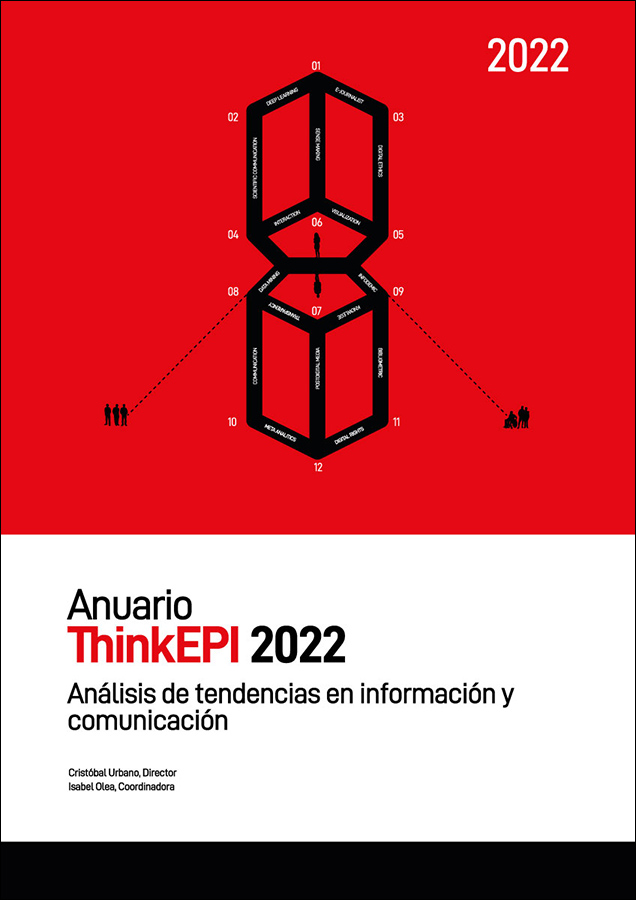Indicadores de medición del acceso abierto: fuentes y herramientas
DOI:
https://doi.org/10.3145/thinkepi.2022.e16a18Palabras clave:
Acceso abierto, Crossref, Indicadores, Monitorización, Repositorios, UnpaywallResumen
La determinación del porcentaje de publicaciones disponibles en acceso abierto es el indicador más pragmático para medir la concreción de las políticas de ciencia abierta y está presente en la mayoría de los planes en este ámbito. Esta nota ofrece un repaso de la bibliografía publicada en la última década sobre la evolución del acceso abierto a la bibliografía científica y el análisis de algunos indicadores de acceso abierto desarrollados en diferentes países. Los resultados ponen de manifiesto que, al crear un indicador de acceso abierto, es necesario tomar decisiones relativas a la colección documental sobre la cual se realizará el cálculo, la herramienta empleada para determinar la disponibilidad en acceso abierto, la definición y tipologías de acceso abierto consideradas, la posible utilización de fuentes de información adicionales, los aspectos temporales y la publicación de la documentación necesaria para garantizar la reproductibilidad del indicador.
Descargas
Citas
Archambault, í‰ric; Amyot, Didier; Deschamps, Philippe; Nicol, Aurore; Provencher, Franí§oise; Rebout, Lise; Roberge, Guillaume (2014). Proportion of open access papers published in peer-reviewed journals at the European and world levels"”1996-2013. European Commision. https://science-metrix.com/sites/default/files/science-metrix/publications/d_1.8_sm_ec_dg-rtd_proportion_oa_1996-2013_v11p.pdf
Basson, Isabel; Simard, Marc-André; Ouangré, Zoé-Aubierge; Sugimoto, Cassidy R.; Larivií¨re, Vincent (2022). "The effect of data sources on the measurement of open access: A comparison of Dimensions and the Web of Science". PLoS one, v. 17, n. 3, e0265545. https://doi.org/10.1371/journal.pone.0265545
Bosman, Jeroen; Kramer, Bianca (2018). "Open access levels: a quantitative exploration using Web of Science and oaDOI data". PeerJ preprints, v. 6, e3520v1. https://doi.org/10.7287/peerj.preprints.3520v1
Else, Holly (2018). "How Unpaywall is transforming open science". Nature, v. 560, pp. 291-292. https://doi.org/10.1038/d41586-018-05968-3
European Commission (2021). Monitoring the open access policy of Horizon 2020. https://doi.org/10.2777/268348
Larivií¨re, Vincent; Sugimoto Cassidy R. (2018). "Do authors comply when funders enforce open access to research?". Nature, v. 562, n. 7728, pp. 483-486. https://doi.org/10.1038/d41586-018-07101-w
Martín-Martín, Alberto; Costas, Rodrigo; Van-Leeuwen, Thed; Delgado-López-Cózar, Emilio (2018). "Evidence of open access of scientific publications in Google Scholar: A large-scale analysis". Journal of informetrics, v. 12, n. 3, pp. 819-841. https://doi.org/10.1016/j.joi.2018.06.012
Martínez-Galindo, Francisco-Jesús; Rubio, Francisco; Fernández-Burguete, Sergio (2022). "Monitorización de los mandatos de acceso abierto a través de repositorios institucionales". Profesional de la información, v. 31, n. 2. https://doi.org/10.3145/epi.2022.mar.04
NORF (2021). National open research landscape report. http://bit.ly/NORFlandscape
Orr, Richard (2021). What is an OA license? https://support.unpaywall.org/support/solutions/articles/44002063718-what-is-an-oa-license-
Philipp, Tobias; Botz, Georg; Kita, Jean-Claude; Richards, Paul; Sí¤nger, Astrid; Siegert, Olaf; Reumaux, Mathilde (2021). Open access monitoring: Guidelines and recommendations for research organisations and funders. https://doi.org/10.5281/zenodo.4905553
Piwowar, Heather; Priem, Jason; Larivií¨re, Vincent; Alperin, Juan-Pablo; Matthias, Lisa; Norlander, Bree; Farley, Ashley; West, Jevin; Haustein, Stefanie (2018). "The state of OA: a large-scale analysis of the prevalence and impact of Open Access articles". PeerJ, v. 6, e4375. https://doi.org/10.7717/peerj.4375
Piwowar, Heather; Priem, Jason; Orr, Richard (2019). "The future of OA: A large-scale analysis projecting open access publication and readership". BioRxiv, 795310. https://doi.org/10.1101/795310
Rebiun (2019a). Recomendaciones sobre la monitorización del acceso abierto. Rebiun Línea 3. Grupo de repositorios. http://hdl.handle.net/20.500.11967/245
Rebiun (2019b). Medición del acceso abierto en las universidades españolas y el CSIC (2014-2018). Rebiun Línea 2. Grupo de acceso abierto. http://hdl.handle.net/20.500.11967/354
Robinson-Garcia, Nicolas; Costas, Rodrigo; Van-Leeuwen, Thed N. (2020). "Open Access uptake by universities worldwide". PeerJ, v. 8, e9410. http://doi.org/10.7717/peerj.9410
Rovira, Anna; Labastida, Ignasi (2019). "The open access observatory". Liber quarterly, v. 29, n. 1. http://doi.org/10.18352/lq.10295
Science-Metrix (2018). Analytical support for bibliometric indicators: Open access availability of scientific publications. https://www.science-metrix.com/sites/default/files/science-metrix/publications/science-metrix_open_access_availability_scientific_publications_report.pdf
Severin, Anna; Egger, Matthias; Eve, Martin-Paul; Hí¼rlimann, Daniel (2018). "Discipline-specific open access publishing practices and barriers to change: an evidence-based review". F1000Research, v. 7. https://doi.org/10.12688%2Ff1000research.17328.2
Suber, Peter (2008). "Gratis and libre open access". SPARC Open access newsletter, n. 124. https://dash.harvard.edu/bitstream/handle/1/4322580/suber_oagratis.html
Descargas
Publicado
Cómo citar
Dimensions


